This article was published on August 5, 2013 and revised on September 15, 2013. The original language used was Traditional Chinese and the following abridged English version was done with Google Translate. I tried to do a manual-proof to take out FUNNY translations; but please keep in mind that I could miss many funny and perhaps not-so-easy-understandable words, phrases, etc. Please blame Google Translate, 
------------------
This article presents to you the early development process of DSLR. The main topic is the Still Video (SV for short ) models based on TV imaging technology in Japan in the 1980s - it was called electronic photography at that time , and then we discuss the Kodak in the late 1980s. Let us review the development during the period when the Japanese system rose and Kodak fell in the early 21st century. The discussion here is limited to 2001, because the subsequent development is a story familiar to most DSLR players. In addition, only the important models will be mentioned here, and those that are relatively minor and special and not widely used will be omitted; each camera mentioned will be shown with photos and basic specifications when it is possible, and the details will be in later articles. Most of the photos in this article are the equipment in my hands. Some photos of rare or unavailable equipment are provided by others (please see the description below the photo). Please note that these photos (whether by myself or others) are copyrighted, and cannot be reposted or used in any way without the consent of the original author.
It took me more than four months to write this article, and it was indeed quite difficult to start from scratch, and some materials are not yet fully prepared and complete; for example, the release of certain models, the date of launch and the technology Details and so on, so this article will update some information from time to time.
Next, let's start with the first digital camera.
First digital camera ( 1975)
In 1969, scientists Willard Boyle and George E. Smith of AT &T Bell Labs ( Bell Lab ) invented the CCD ( Charge-Coupled Device ) photosensitive element widely used in today's digital cameras. Two years later ( 1971 ), Bell Labs scientists MF Tompsett , GF Amelio , WJ Bertram Jr. , RR Buckley , WJ McNamara , JC Mikkelsen Jr and DA Sealer recorded black and white images with CCD for the first time. Four years later ( 1975 ) , Steven Sasson , an engineer at Kodak , built the first digital camera that could record black and white images with a resolution of 100x100 (pictured below), using cassette tapes to store images. At that time, there were no CDs and memory cards, and the floppy disks were the -inch version that was nearing its life-span, the 5 -inch version was yet to be popularized, and the 3.5 -inch version had not yet appeared, so it was a reasonable choice to use cassette tapes. The speed of the tape is quite slow. It takes 23 seconds for the camera to record the image and completely store the image on the cassette tape . The whole system weighs 3.6 kg. Then, Bryce Bayer of Kodak obtained a patent for recording color images in 1976 , and most digital cameras currently use Bayer 's technology. Steven Sasson received the National Medal of Technology and Innovation from President Obama on November 17 , 2009 .
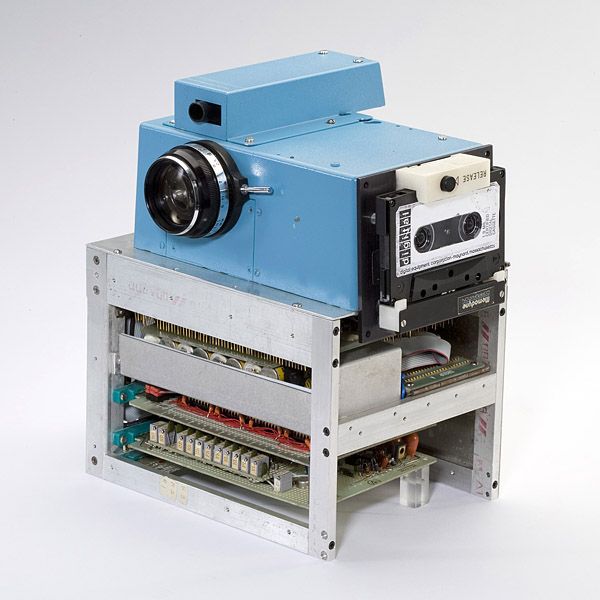
Single-frame Video ( SV) cameras (1980s)
Although digital cameras have been used in astronomy, space, national defense, and scientific research for a long time, the development of consumer products is quite slow. The first one to try to enter the market was the Sony Mavica in 1981 ( MAgnetic VIdeo CAmera, which has nothing to do with the later Mavica models ), but this was a model that recorded analog TV signals, not strictly a digital camera. It is natural for the Sony Mavica to use television technology, since television cameras already used CCD technology in the 1980s . This type of camera records a single frame of a television image and stores it on a 2-inch floppy disk, usually one frame per track. When playing on a TV, the image is shown by repeatedly reading and playing the same picture. Therefore, this model is called a Still Video Camera (or SV camera), that is, a still (single frame) video camera, and electronic cameras in the 1980s are all of this type of design. This Sony Mavica is just a prototype and not actually produced: the first picture below is the Mavica and 2- inch floppy disk in the display case, and the second isMavica and its three lenses.
Sony Mavica (1981) -- web photo
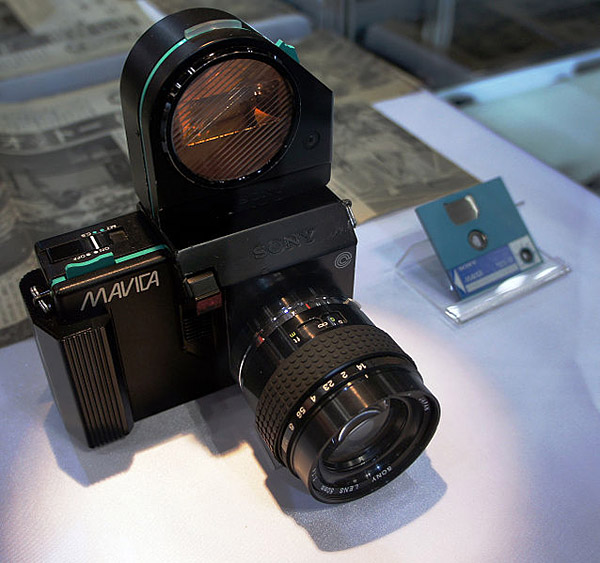
Sony Mavica (1981) -- web photo
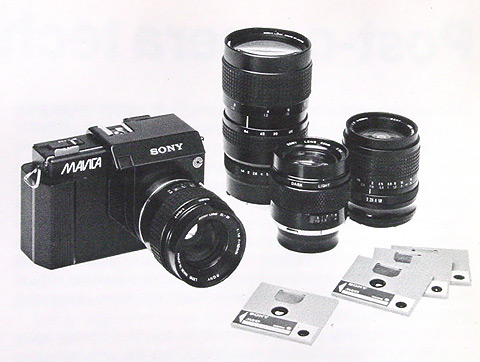
The next milestone came in 1984 in Los Angeles, USA. Canon released a prototype before the Olympics, let reporters try it out during the Olympics, and the photos taken were sent back to Japan with telephone lines and published by the Yomiuri Shimbun. This was the first electronic camera that was actually used in the history of cameras, but it still records TV analog signals. Two years later ( 1986 ), both Canon and Sony launched the single-frame video model Still Video SLR, hereinafter referred to as SV SLR , the earlier Canon model Canon RC-701 ( RC stands for Realtime Camera ), and the later Sony Mavica MVC-A7AF and Sony Mavica MVC-2000 .
Canon RC-701 (see first photo below) is a modified version of the 1984 prototype. It has a mirror, uses 2/3 inch CCD ( 8.8x6.6mm , crop factor is 3.93 relative to 135 film ), The horizontal resolution is 780 pixels (this is roughly the resolution of a TV 320x300 ), and the images are stored on a 2- inch floppy disk. Canon RC-701 has three lenses: 11-66mm f/1.2 (equivalent to 43-260mm of 135 film , the same below), 50-150mm f/2.8 ( 195-585mm ), and 6mm f/1.8 ( 24mm ). This is just the camera part, the complete system also includes video projector, printer, film laminating machine, and telephone transmitter. Most of the SV models at that time and in the next few years had a video recorder, which was convenient for playing the images on the floppy disk on the TV, or converting the TV analog numbers into digital numbers for storage. Since then, Canon has also releasedCanon RC-760 ( 1987 , SV SLR ) and several non- SLR models, second photo below is Canon RC-470 ( 1988 ). Since 1986 , Japanese manufacturers have launched several SV models one after another, and most SV cameras are almost outdated as soon as they go on the market, because Kodak has already produced the familiar DSLR in 1987 , but these cameras were only sold to the U.S. government and were not marketed (see discussion in the next section).
Canon RC-701 (1986)
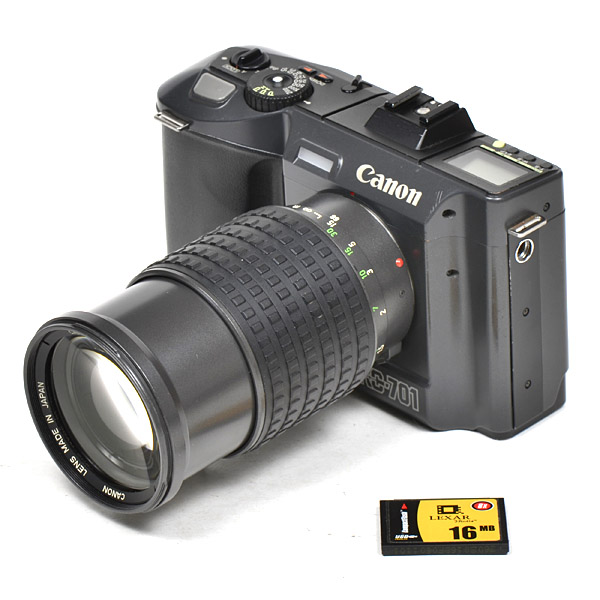
Canon RC-470 (1988)
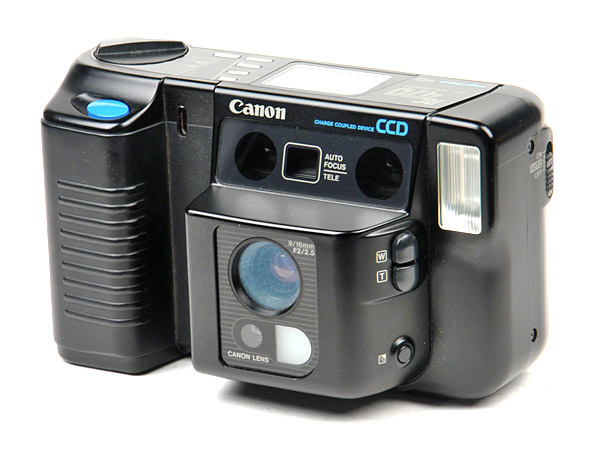
As mentioned earlier, Sony also launched the Sony Mavica MVC-A7AF in 1986. It is an SV SLR with a 2/3 -inch CCD . It has a 12-72mm f /1.4 ( 47 -283mm ) lens, can focus manually or automatically, and the user can add voice instructions to the photos. Sony also released the Sony Mavica MVC-2000 later in the same year , which has a few differences from the MVC-A7AF (for example, there is no audio description function but the HI BAND function is added ). There is a saying that the MVC- 2000 uses a 13X zoom ratio that cannot be interchanged, but after looking at a lot of MVC -2000 real machines and photos, the lenses are all 12-72mm , which is 6X rather than 13X , this needs to be further verified. The first photo below is of the Sony Mavica MVC-A7AF and the second is its lens.
Sony Mavica MVC-A7AF (1986)
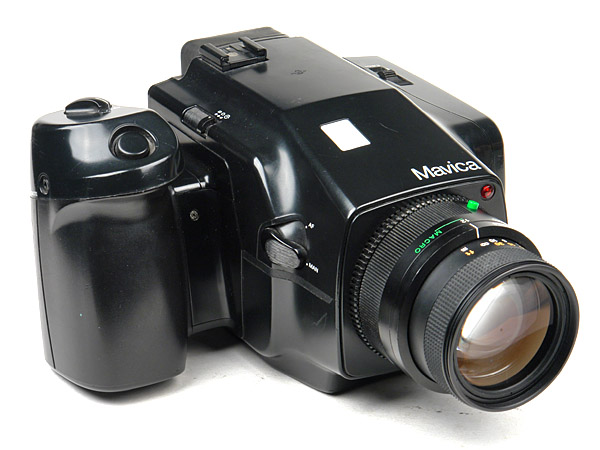
Sony Mavica MVC-A7AF Lens (1986)
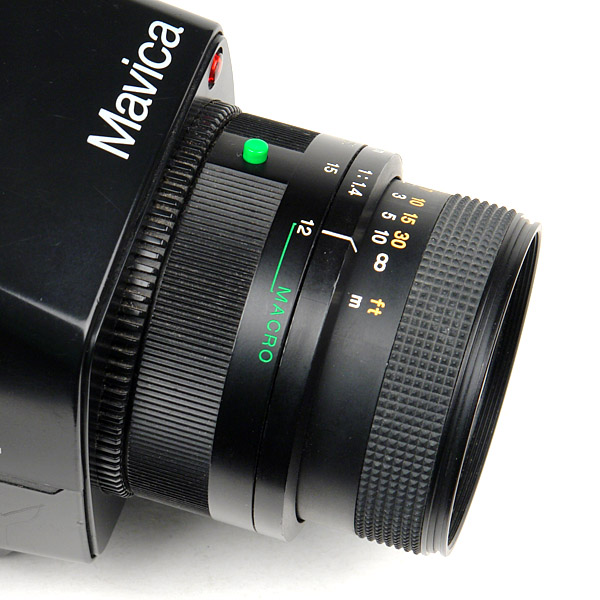
The Sony MVC-A7AF and MVC-2000 did not have much success, but the Mavica MVC-5000, launched in 1989, became famous because of the Tiananmen incident. When the Tiananmen incident happened, CNN published a photo taken by reporter John Schaer of a young man holding a tank. At that time, it was said that the photo was shot with a Sony Mavica MVC-5000 , making it a hit. After verification, reporter John Schaer personally said that he used Sony BVU 330 to record the video, and then used Sony 's digital video transmitter to capture some of the recorded images and sent them back to the US headquarters through telephone lines. The video part was brought back to the United States by tourists. (see this article ). Even so,
many people (perhaps unaware of the truth) still believe, and continue to circulate, that the photos were taken with a Sony Mavica MVC-5000 .
Below is a photo of the Sony Mavica MVC-5000 , an SLR with interchangeable lenses , the adapter is similar to but not the same as the Canon EOS because the EOS lens cannot be mounted on the body and is almost impossible to focus; Sony also produces one The MCL-200N mount for Nikon lenses can be used . The Mavica MVC-5000 has two 2/3 -inch CCDs , one records brightness and the other records color, with a total of 720K pixels. Sony 's manual states that the Mavica MVC-5000 has three manual lenses: MCL-05H Wide 5 mm , MCL-06T Wide 6.5mm , and MCL-913T 9.5-123.5mm f/1.8 (this is the lens in the photo); the 9.5-123.5mm is made by Canon , but I don’t know whether the first two are also Canon products. Because the size of the 2/3 inch sensor is 8.8x6.6mm and the diagonal length is 11mm , the crop factor of the Sony Mavica MVC-5000 relative to FF is 3.93 ( =43.3/11 ). Thus, the above 5mm , 6.5mm and 9.5-123.5mm are respectively equivalent to 20mm ( =5x3.93 ), 26mm ( =6.5x3.93 ) and 37-485mm of 135 film .
Sony Mavica MVC-5000 (1989)
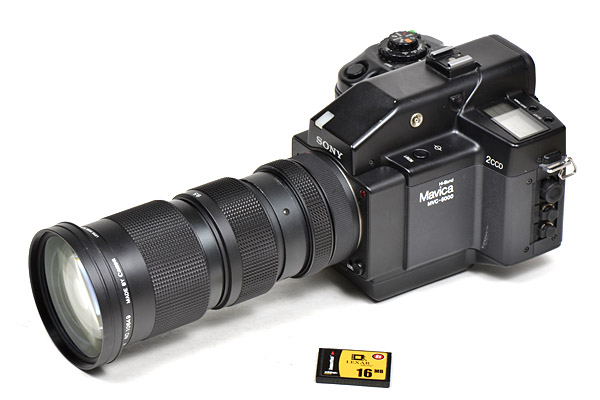
In the professional market, the Sony Mavica MVC-5000 was considered a very successful model, although the sales volume was not large (because it is only sold to professionals). Sony launched the Sony Mavica MVC-7000 in 1992 , but this was the end of the SV model, because the real DSLR was produced in the Kodak laboratory and sold to the US government units, and Kodak also launched the Nikon F3 based model in 1991 . The Kodak DCS officially marked the arrival of the digital generation.
Nikon entered the SV field later than Sony and Canon did. It was not until 1986 that the prototype Nikon Still Video Camera Model I ( SVC ) was launched, but it was not produced. This is a SV-style SLR using a 2/3 -inch 300,000 -pixel CCD and a 2- inch floppy disk. It has two lenses : 6mm f/1.6 and 10-40mm f/1.4 . Nikon launched the SV model Nikon QV-1000C in 1986, still using a 2/3 -inch CCD with a resolution of 380K and an available ISO of 400, 800 and 1600 , and equipped with two lenses 10-40mm f/1.4 and 11-120mm f/2 , the images are stored in a 2 -inch floppy disk, but only black and white images are recorded. The production of Nikon QV-1000C is very small, and most of them are used for testing and evaluation by the press. Associated Press reporter Ron Edmonds once used it to shoot the 1989 US Presidential Inauguration.
Nikon QV-1000C (1988) -- Image Credit: Mr. Jarle Aasland @ NikonWeb
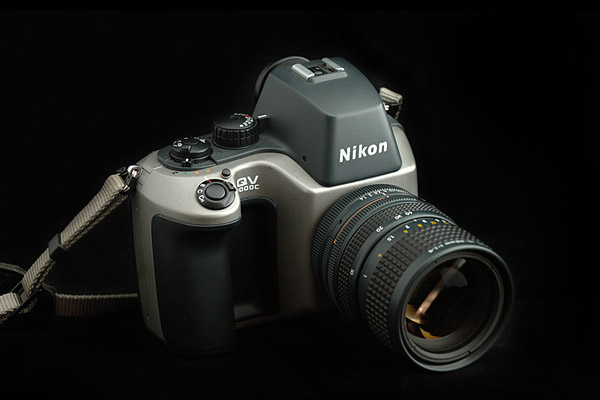
From the 1980s to the early 1990s , in addition to Canon , Nikon and Sony products , other manufacturers showed prototypes and produced a small number of products . They are all SV models , but it is not known whether they are SLRs . What is certain is that the main target of these products is the press rather than general use, because the volume was not high (it is said that the production of Nikon QV-1000C is less than 200 units) and the price is extremely high. Since the early 1990s , various companies have launched digital models one after another, so the development of SV models ended in the 1990s .
Kodak's achievements
Kodak produced the first photosensitive chip in history to exceed 1 MP (actually 1.4 MP ) in 1986 , and the US government ordered cameras using it the following year ( 1987 ) . Kodak engineers installed the photosensitive chip on the back of a Canon New F-1 (the first photo below), and put the other parts in a box. The box and the back of the machine were connected with a cable (the second photo). The photos were stored on 8mm tape inside the box , and the images were then read with other equipment (third photo). This camera is called Electro-Optic Camera , it is of course an SLR , and it is the first D SLR in history . The fourth photo is the result of scanning the 8x10 photo taken by the Electro-Optic Camera (the original photo is a bit damaged), and the original author is Mr. James McGarvey,
the chief engineer who designed the Electro-Optic Camera.
Kodak Electro-Optic Camera (1987) -- Image Credit: Mr. James McGarvey
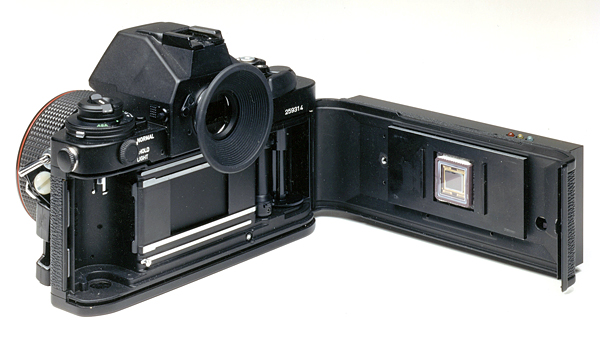
Kodak Electro-Optic Camera (1987) -- Image Credit: Mr. James McGarvey
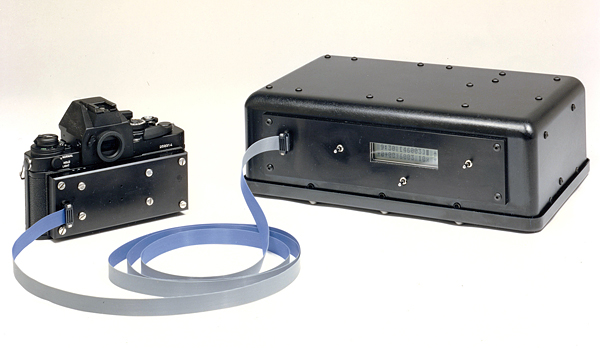
Kodak Electro-Optic Camera (1987) -- Image Credit: Mr. James McGarvey
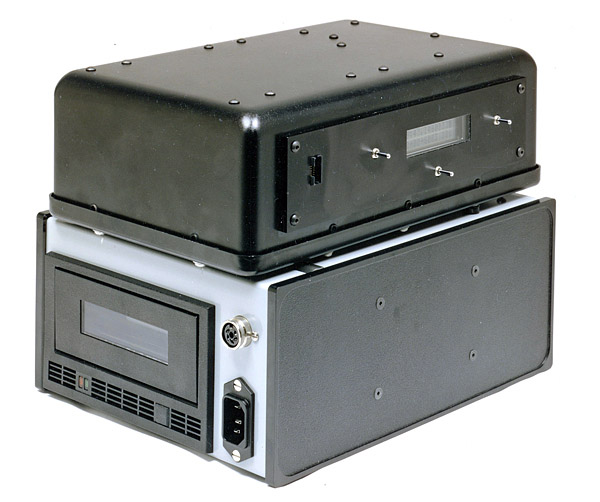
Kodak Electro-Optic Camera (1987) -- Image Credit: Mr. James McGarvey
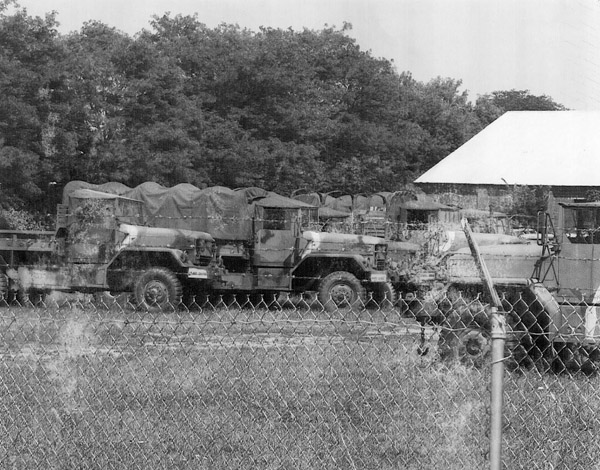
In the development plan of Electro-Optic Camera in 1987 , Mr. Ken Cupery was the project manager of Electro-Optic Camera , Mr. James McGarvey was the chief engineer, responsible for the camera design part, Mr. Bill Toohey designed the analog circuit of CCD , and Mr. Tom McCarthy assembled the whole system. The fourth photo above is a test photo of Mr. McGarvey . It is the earliest DSLR photo. There is further information in the extended reading section of this article.
After the Electro-Optic Camera was delivered in 1988 , Kodak engineers used Canon New F-1 body to recreate two DSLRs for display , called Tactical Camera . In March 1989 , the Nikon F3 body was used to create the Hawkeye II (picture below), the part other than the photosensitive chip was installed in the Nikon F3 film winding motor ( Hawkeye II has no automatic film loading function), and the resolution is 1280x1024 .
Kodak Hawkeye II (1989) -- Image Credit: Mr. James McGarvey, USA
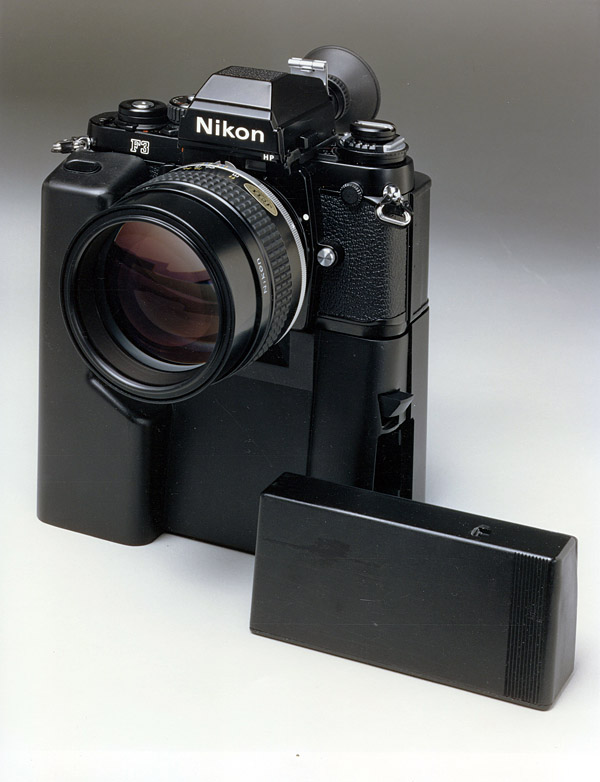
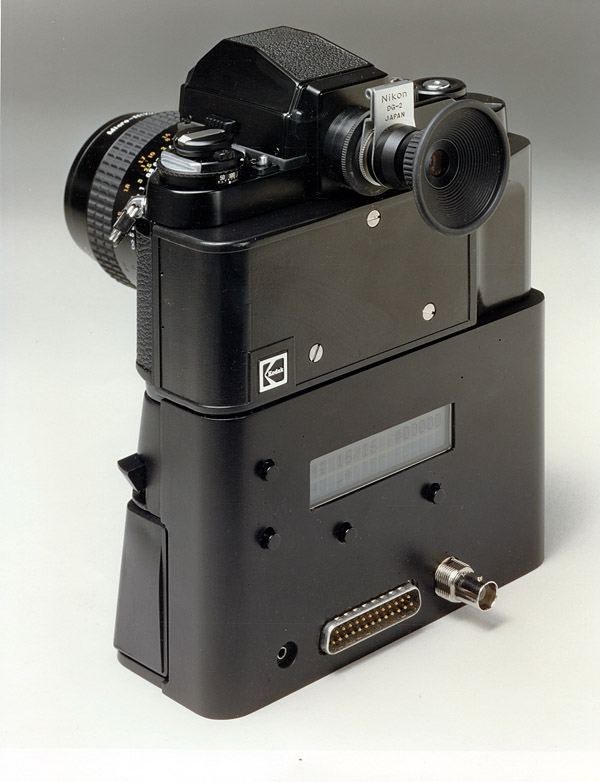
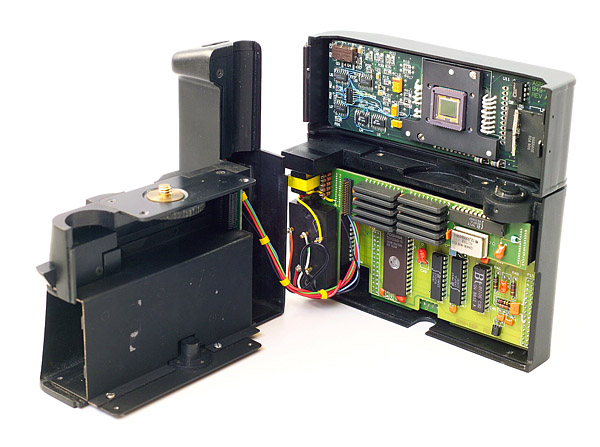
In 1990 , Kodak engineers further improved the Hawkeye II , added a film winding motor (see the photo below), and moved a lot of equipment out of the camera body and into the camera bag box .
Kodak Hawkeye II (1990) -- Image Credit: Mr. James McGarvey, USA
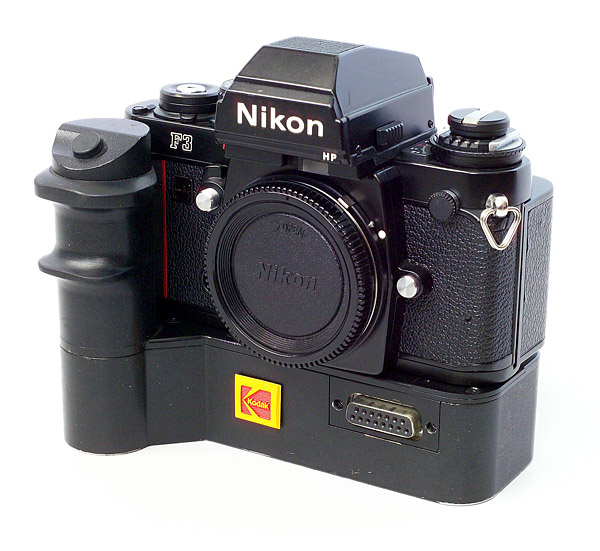
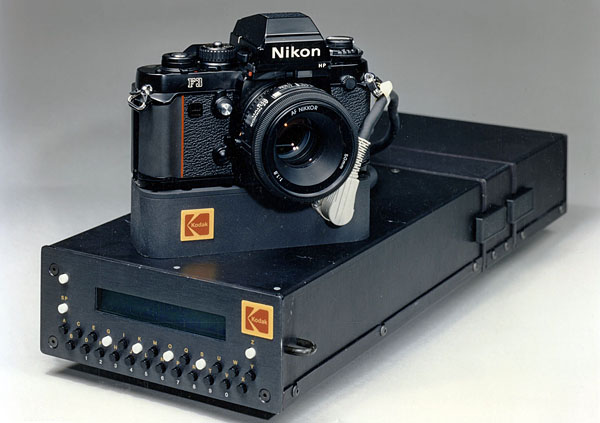
DSLR Officially Debut
Kodak repackaged the Hawkeye II under the Kodak Professional DCS ( Digital Camera System ) name and marketed it in May 1991. This was the first DSLR to actually go on the market ( photo below ) . In terms of resolution, the Electro-Optic Camera in 1988 was 1320x1035 ( 1.4MP ), the Hawkeye II in 1989 and the Professional DCS launched in 1991 were 1280x1024 ( 1.3MP ), and the Nikon N8008s/F-801s autofocus machine was used in 1992. The next generation Professional DCS 200 increased to 1524x1012 ( 1.5MP ), and in 1995 Professional DCS 460 increased to 3060x2036 ( 6.2MP ). Kodak has also produced several medium-format camera backs, and the photosensitive chips of Leica M8 and M9 are also Kodak products. Perhaps because the next generation model is Kodak Professional DCS 200 , many documents used Kodak Professional DCS as Kodak Professional DCS-100 , but the body in the photo only has the word DCS instead of DCS-100 , so DCS-100 may be a rumor, because Kodak did not make cameras of this type. For convenience below, Kodak Professional DCS is referred to as Kodak DCS for short .
Kodak Professional DCS (1991) -- Image Credit: Kodak
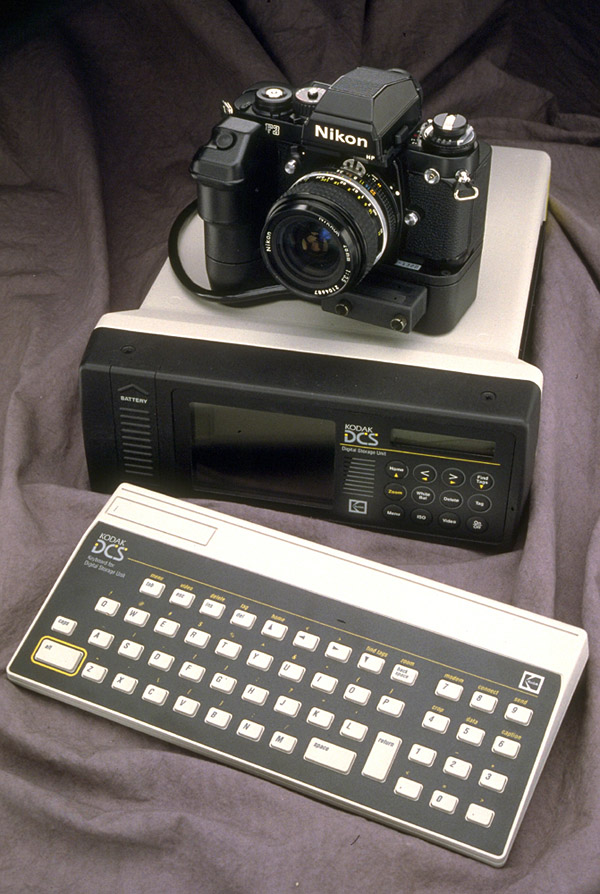
---------------------------
This is the end of PART I. PART II and PART III will be posted a few days later. During the process of making this post available here, I found something odd with the editor being used to constructing a message. I may be wrong and please correct me:
------------------
This article presents to you the early development process of DSLR. The main topic is the Still Video (SV for short ) models based on TV imaging technology in Japan in the 1980s - it was called electronic photography at that time , and then we discuss the Kodak in the late 1980s. Let us review the development during the period when the Japanese system rose and Kodak fell in the early 21st century. The discussion here is limited to 2001, because the subsequent development is a story familiar to most DSLR players. In addition, only the important models will be mentioned here, and those that are relatively minor and special and not widely used will be omitted; each camera mentioned will be shown with photos and basic specifications when it is possible, and the details will be in later articles. Most of the photos in this article are the equipment in my hands. Some photos of rare or unavailable equipment are provided by others (please see the description below the photo). Please note that these photos (whether by myself or others) are copyrighted, and cannot be reposted or used in any way without the consent of the original author.
It took me more than four months to write this article, and it was indeed quite difficult to start from scratch, and some materials are not yet fully prepared and complete; for example, the release of certain models, the date of launch and the technology Details and so on, so this article will update some information from time to time.
Next, let's start with the first digital camera.
First digital camera ( 1975)
In 1969, scientists Willard Boyle and George E. Smith of AT &T Bell Labs ( Bell Lab ) invented the CCD ( Charge-Coupled Device ) photosensitive element widely used in today's digital cameras. Two years later ( 1971 ), Bell Labs scientists MF Tompsett , GF Amelio , WJ Bertram Jr. , RR Buckley , WJ McNamara , JC Mikkelsen Jr and DA Sealer recorded black and white images with CCD for the first time. Four years later ( 1975 ) , Steven Sasson , an engineer at Kodak , built the first digital camera that could record black and white images with a resolution of 100x100 (pictured below), using cassette tapes to store images. At that time, there were no CDs and memory cards, and the floppy disks were the -inch version that was nearing its life-span, the 5 -inch version was yet to be popularized, and the 3.5 -inch version had not yet appeared, so it was a reasonable choice to use cassette tapes. The speed of the tape is quite slow. It takes 23 seconds for the camera to record the image and completely store the image on the cassette tape . The whole system weighs 3.6 kg. Then, Bryce Bayer of Kodak obtained a patent for recording color images in 1976 , and most digital cameras currently use Bayer 's technology. Steven Sasson received the National Medal of Technology and Innovation from President Obama on November 17 , 2009 .

Single-frame Video ( SV) cameras (1980s)
Although digital cameras have been used in astronomy, space, national defense, and scientific research for a long time, the development of consumer products is quite slow. The first one to try to enter the market was the Sony Mavica in 1981 ( MAgnetic VIdeo CAmera, which has nothing to do with the later Mavica models ), but this was a model that recorded analog TV signals, not strictly a digital camera. It is natural for the Sony Mavica to use television technology, since television cameras already used CCD technology in the 1980s . This type of camera records a single frame of a television image and stores it on a 2-inch floppy disk, usually one frame per track. When playing on a TV, the image is shown by repeatedly reading and playing the same picture. Therefore, this model is called a Still Video Camera (or SV camera), that is, a still (single frame) video camera, and electronic cameras in the 1980s are all of this type of design. This Sony Mavica is just a prototype and not actually produced: the first picture below is the Mavica and 2- inch floppy disk in the display case, and the second isMavica and its three lenses.
Sony Mavica (1981) -- web photo

Sony Mavica (1981) -- web photo

The next milestone came in 1984 in Los Angeles, USA. Canon released a prototype before the Olympics, let reporters try it out during the Olympics, and the photos taken were sent back to Japan with telephone lines and published by the Yomiuri Shimbun. This was the first electronic camera that was actually used in the history of cameras, but it still records TV analog signals. Two years later ( 1986 ), both Canon and Sony launched the single-frame video model Still Video SLR, hereinafter referred to as SV SLR , the earlier Canon model Canon RC-701 ( RC stands for Realtime Camera ), and the later Sony Mavica MVC-A7AF and Sony Mavica MVC-2000 .
Canon RC-701 (see first photo below) is a modified version of the 1984 prototype. It has a mirror, uses 2/3 inch CCD ( 8.8x6.6mm , crop factor is 3.93 relative to 135 film ), The horizontal resolution is 780 pixels (this is roughly the resolution of a TV 320x300 ), and the images are stored on a 2- inch floppy disk. Canon RC-701 has three lenses: 11-66mm f/1.2 (equivalent to 43-260mm of 135 film , the same below), 50-150mm f/2.8 ( 195-585mm ), and 6mm f/1.8 ( 24mm ). This is just the camera part, the complete system also includes video projector, printer, film laminating machine, and telephone transmitter. Most of the SV models at that time and in the next few years had a video recorder, which was convenient for playing the images on the floppy disk on the TV, or converting the TV analog numbers into digital numbers for storage. Since then, Canon has also releasedCanon RC-760 ( 1987 , SV SLR ) and several non- SLR models, second photo below is Canon RC-470 ( 1988 ). Since 1986 , Japanese manufacturers have launched several SV models one after another, and most SV cameras are almost outdated as soon as they go on the market, because Kodak has already produced the familiar DSLR in 1987 , but these cameras were only sold to the U.S. government and were not marketed (see discussion in the next section).
Canon RC-701 (1986)

Canon RC-470 (1988)

As mentioned earlier, Sony also launched the Sony Mavica MVC-A7AF in 1986. It is an SV SLR with a 2/3 -inch CCD . It has a 12-72mm f /1.4 ( 47 -283mm ) lens, can focus manually or automatically, and the user can add voice instructions to the photos. Sony also released the Sony Mavica MVC-2000 later in the same year , which has a few differences from the MVC-A7AF (for example, there is no audio description function but the HI BAND function is added ). There is a saying that the MVC- 2000 uses a 13X zoom ratio that cannot be interchanged, but after looking at a lot of MVC -2000 real machines and photos, the lenses are all 12-72mm , which is 6X rather than 13X , this needs to be further verified. The first photo below is of the Sony Mavica MVC-A7AF and the second is its lens.
Sony Mavica MVC-A7AF (1986)

Sony Mavica MVC-A7AF Lens (1986)

The Sony MVC-A7AF and MVC-2000 did not have much success, but the Mavica MVC-5000, launched in 1989, became famous because of the Tiananmen incident. When the Tiananmen incident happened, CNN published a photo taken by reporter John Schaer of a young man holding a tank. At that time, it was said that the photo was shot with a Sony Mavica MVC-5000 , making it a hit. After verification, reporter John Schaer personally said that he used Sony BVU 330 to record the video, and then used Sony 's digital video transmitter to capture some of the recorded images and sent them back to the US headquarters through telephone lines. The video part was brought back to the United States by tourists. (see this article ). Even so,
many people (perhaps unaware of the truth) still believe, and continue to circulate, that the photos were taken with a Sony Mavica MVC-5000 .
Below is a photo of the Sony Mavica MVC-5000 , an SLR with interchangeable lenses , the adapter is similar to but not the same as the Canon EOS because the EOS lens cannot be mounted on the body and is almost impossible to focus; Sony also produces one The MCL-200N mount for Nikon lenses can be used . The Mavica MVC-5000 has two 2/3 -inch CCDs , one records brightness and the other records color, with a total of 720K pixels. Sony 's manual states that the Mavica MVC-5000 has three manual lenses: MCL-05H Wide 5 mm , MCL-06T Wide 6.5mm , and MCL-913T 9.5-123.5mm f/1.8 (this is the lens in the photo); the 9.5-123.5mm is made by Canon , but I don’t know whether the first two are also Canon products. Because the size of the 2/3 inch sensor is 8.8x6.6mm and the diagonal length is 11mm , the crop factor of the Sony Mavica MVC-5000 relative to FF is 3.93 ( =43.3/11 ). Thus, the above 5mm , 6.5mm and 9.5-123.5mm are respectively equivalent to 20mm ( =5x3.93 ), 26mm ( =6.5x3.93 ) and 37-485mm of 135 film .
Sony Mavica MVC-5000 (1989)

In the professional market, the Sony Mavica MVC-5000 was considered a very successful model, although the sales volume was not large (because it is only sold to professionals). Sony launched the Sony Mavica MVC-7000 in 1992 , but this was the end of the SV model, because the real DSLR was produced in the Kodak laboratory and sold to the US government units, and Kodak also launched the Nikon F3 based model in 1991 . The Kodak DCS officially marked the arrival of the digital generation.
Nikon entered the SV field later than Sony and Canon did. It was not until 1986 that the prototype Nikon Still Video Camera Model I ( SVC ) was launched, but it was not produced. This is a SV-style SLR using a 2/3 -inch 300,000 -pixel CCD and a 2- inch floppy disk. It has two lenses : 6mm f/1.6 and 10-40mm f/1.4 . Nikon launched the SV model Nikon QV-1000C in 1986, still using a 2/3 -inch CCD with a resolution of 380K and an available ISO of 400, 800 and 1600 , and equipped with two lenses 10-40mm f/1.4 and 11-120mm f/2 , the images are stored in a 2 -inch floppy disk, but only black and white images are recorded. The production of Nikon QV-1000C is very small, and most of them are used for testing and evaluation by the press. Associated Press reporter Ron Edmonds once used it to shoot the 1989 US Presidential Inauguration.
Nikon QV-1000C (1988) -- Image Credit: Mr. Jarle Aasland @ NikonWeb

From the 1980s to the early 1990s , in addition to Canon , Nikon and Sony products , other manufacturers showed prototypes and produced a small number of products . They are all SV models , but it is not known whether they are SLRs . What is certain is that the main target of these products is the press rather than general use, because the volume was not high (it is said that the production of Nikon QV-1000C is less than 200 units) and the price is extremely high. Since the early 1990s , various companies have launched digital models one after another, so the development of SV models ended in the 1990s .
Kodak's achievements
Kodak produced the first photosensitive chip in history to exceed 1 MP (actually 1.4 MP ) in 1986 , and the US government ordered cameras using it the following year ( 1987 ) . Kodak engineers installed the photosensitive chip on the back of a Canon New F-1 (the first photo below), and put the other parts in a box. The box and the back of the machine were connected with a cable (the second photo). The photos were stored on 8mm tape inside the box , and the images were then read with other equipment (third photo). This camera is called Electro-Optic Camera , it is of course an SLR , and it is the first D SLR in history . The fourth photo is the result of scanning the 8x10 photo taken by the Electro-Optic Camera (the original photo is a bit damaged), and the original author is Mr. James McGarvey,
the chief engineer who designed the Electro-Optic Camera.
Kodak Electro-Optic Camera (1987) -- Image Credit: Mr. James McGarvey

Kodak Electro-Optic Camera (1987) -- Image Credit: Mr. James McGarvey

Kodak Electro-Optic Camera (1987) -- Image Credit: Mr. James McGarvey

Kodak Electro-Optic Camera (1987) -- Image Credit: Mr. James McGarvey

In the development plan of Electro-Optic Camera in 1987 , Mr. Ken Cupery was the project manager of Electro-Optic Camera , Mr. James McGarvey was the chief engineer, responsible for the camera design part, Mr. Bill Toohey designed the analog circuit of CCD , and Mr. Tom McCarthy assembled the whole system. The fourth photo above is a test photo of Mr. McGarvey . It is the earliest DSLR photo. There is further information in the extended reading section of this article.
After the Electro-Optic Camera was delivered in 1988 , Kodak engineers used Canon New F-1 body to recreate two DSLRs for display , called Tactical Camera . In March 1989 , the Nikon F3 body was used to create the Hawkeye II (picture below), the part other than the photosensitive chip was installed in the Nikon F3 film winding motor ( Hawkeye II has no automatic film loading function), and the resolution is 1280x1024 .
Kodak Hawkeye II (1989) -- Image Credit: Mr. James McGarvey, USA



In 1990 , Kodak engineers further improved the Hawkeye II , added a film winding motor (see the photo below), and moved a lot of equipment out of the camera body and into the camera bag box .
Kodak Hawkeye II (1990) -- Image Credit: Mr. James McGarvey, USA


DSLR Officially Debut
Kodak repackaged the Hawkeye II under the Kodak Professional DCS ( Digital Camera System ) name and marketed it in May 1991. This was the first DSLR to actually go on the market ( photo below ) . In terms of resolution, the Electro-Optic Camera in 1988 was 1320x1035 ( 1.4MP ), the Hawkeye II in 1989 and the Professional DCS launched in 1991 were 1280x1024 ( 1.3MP ), and the Nikon N8008s/F-801s autofocus machine was used in 1992. The next generation Professional DCS 200 increased to 1524x1012 ( 1.5MP ), and in 1995 Professional DCS 460 increased to 3060x2036 ( 6.2MP ). Kodak has also produced several medium-format camera backs, and the photosensitive chips of Leica M8 and M9 are also Kodak products. Perhaps because the next generation model is Kodak Professional DCS 200 , many documents used Kodak Professional DCS as Kodak Professional DCS-100 , but the body in the photo only has the word DCS instead of DCS-100 , so DCS-100 may be a rumor, because Kodak did not make cameras of this type. For convenience below, Kodak Professional DCS is referred to as Kodak DCS for short .
Kodak Professional DCS (1991) -- Image Credit: Kodak

---------------------------
This is the end of PART I. PART II and PART III will be posted a few days later. During the process of making this post available here, I found something odd with the editor being used to constructing a message. I may be wrong and please correct me:
- A HARD carriage return could be added when I change the font color. This CR cannot be deleted.
- For some reason, after changing the normal font to B, I cannot switch it back to normal. As a result, about 50% of this post is in the bold face.
- Yes, text can be aligned left and right fully and centered; but, figures and images cannot be centered.
- Superscript and subscript are not available. As a scientist/engineer, I confess that I hate MS Word very much because doing subscript and superscript is very painful. Most scientists and engineers perhaps are using a form of LaTeX/TeX for their publication, just because MS Word cannot do the job easily.
- Why 20 images? I did not consume any image space and all images are just links to another site.